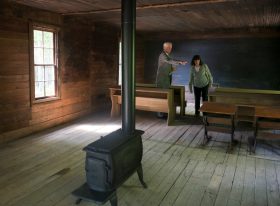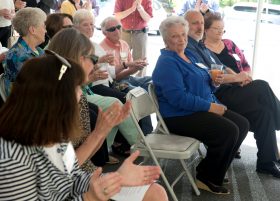Members of the Elon University community gathered May 6, 2014, to dedicate a restored antebellum schoolhouse believed to be the only one of its kind in North Carolina still standing in its original location.

Construction and operational funds were split between the county and the state when it first opened, but within a decade, that support disappeared as Tar Heel lawmakers diverted money to support North Carolina’s involvement in the Civil War. The school closed until the 1870s when lawmakers made another effort to build a public education system.
For the next few decades, what was originally called the Travis Creek School, and later renamed the Cable School after the name of the man who owned the land, welcomed children from as many as five miles away to learn from teachers who often lived in the very same building. No one knows exactly when the school closed – historical records have yet to illustrate a precise date – but it would eventually shutter and be used for various storage purposes over the next century.
On Tuesday afternoon, four years after Elon University received the property as a generous gift from the family that had owned it for generations, that same schoolhouse looked almost exactly like it would have on the day it opened.

“We feel that it’s very appropriate in Elon’s 125th anniversary year that we have this opportunity to think about celebrating a very special place of humble beginnings,” Lambert said. “This is one of the oldest school buildings in the state of North Carolina on its original site, which is something to really treasure.”
Renovations were made possible with support from Glen Raven Inc. and Allen Gant Jr., the North Carolina company’s chief executive officer and a member of Elon’s board of trustees. At the university, Executive Vice President Gerry Francis, University Historian George Troxler and Archivist Katie Nash lent assistance to the effort.
So did students led by Assistant Professor Marna Winter in the School of Education. Winter teachers a language arts and social studies methodology course, and recent classes have researched the types of furnishings and educational materials used in mid 19th century schools, even taking field trips to historical sites like Colonial Williamsburg in Virginia.
Also present at the ceremony was Elon President Emeritus J. Earl Danieley ’46. Danieley’s great-great grandfather, Alfred Iseley, taught at the school in the 1850s. Danieley’s uncle, Frank Iseley, taught there, too, following the Civil War, and it was Frank Iseley who later helped clear the land where Elon College would be built in 1889.

Troxler noted that at least two other “common schools” as they were known in the 1850s still exist in North Carolina, though neither remains in its original location. “If you have an appreciation for authenticity, you are in the right place this afternoon,” Carole Troxler said. “We are celebrating something unique here.”
Troxler guided efforts about a decade ago to clear the schoolhouse of the brush and foliage that had overtaken the property in recent years. She actively involved her own history students in the Phi Alpha Theta national history honor society, as well as North Carolina Teaching Fellows.
Long said the school will be used as a learning resource for students in the School of Education, and the university will make it available for school field trips, local church groups, or organizations like the Boy Scouts and Girl Scouts where members seek to learn more about North Carolina history.
“This project has been a unique and relevant learning opportunity,” Long said.


